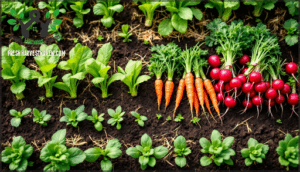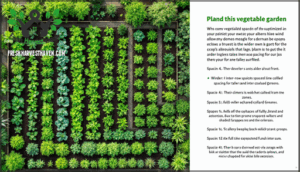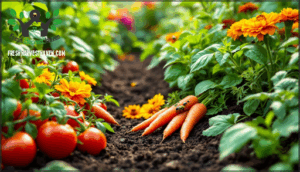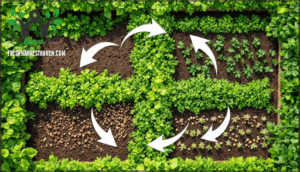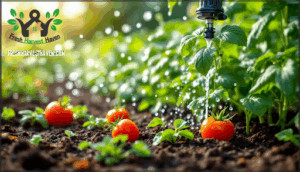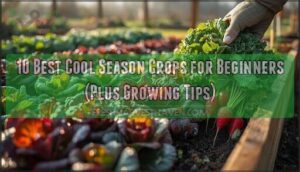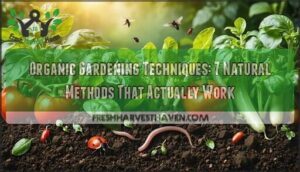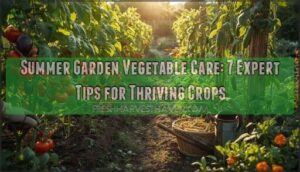This site is supported by our readers. We may earn a commission, at no cost to you, if you purchase through links.
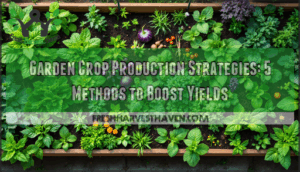
The difference between a struggling garden and a thriving one often comes down to five core practices: maximizing every inch through strategic plant placement, pairing crops that support each other’s growth, rotating families to outsmart pests and disease, building soil that works harder with each season, and delivering water exactly where it’s needed.
When you align these methods with your garden’s unique conditions, you’re not just growing more food—you’re creating a system that becomes more productive year after year.
Table Of Contents
- Key Takeaways
- Maximizing Garden Space Efficiently
- Selecting Compatible Plant Combinations
- Planning Crop Rotations for Healthy Gardens
- Building and Maintaining Healthy Soil
- Improving Water Efficiency and Irrigation
- Frequently Asked Questions (FAQs)
- How do you plan a crop rotation?
- Why is crop rotation important in a garden?
- How do I organize my crops?
- How can I maximize my Garden?
- Can a crop rotation system be used in a garden?
- How do you plan a farm?
- How do I test my garden soil annually?
- What vegetables grow best in partial shade?
- When should I start seeds indoors vs outdoors?
- How do I identify and treat common plant diseases?
- Conclusion
Key Takeaways
- A backyard plot of just 100 square feet can yield over 200 pounds of vegetables annually when you combine strategic plant placement, companion planting, crop rotation, soil building, and targeted watering—practices that create a self-reinforcing system that becomes more productive with each passing season.
- Interplanting compatible crops and using vertical growing methods can boost yields by 30-50% while reducing water needs by up to 70%, transforming even modest garden spaces into highly productive zones through three-dimensional thinking rather than treating beds as flat surfaces.
- Rotating plant families through different garden sections on a three- to four-year cycle disrupts pest lifecycles and reduces soil-borne disease by up to 80%, while legumes naturally replenish nitrogen that heavy feeders deplete, creating a self-sustaining fertility cycle that cuts fertilizer costs by 30%.
- Building soil health through regular composting increases organic matter by up to 259%, combining this with mulching and drip irrigation cuts water use by 40-60% while maintaining moisture levels that support 20-50% higher crop yields compared to conventional methods.
Maximizing Garden Space Efficiently
Your garden doesn’t have to be sprawling to be productive—in fact, smart space management can turn even a modest plot into a serious vegetable producer. The key is thinking strategically about how you arrange your plants, time your plantings, and use your available ground.
Let’s walk through the practical methods that’ll help you grow more food in the space you’ve got.
Interplanting Vegetables for Dense Yields
When you interplant vegetables, you’re basically weaving multiple crops into the same garden bed—a strategy that transforms wasted space into productive zones. This approach boosts your total yield by up to 32%, since different plants occupy different soil depths and light zones.
Consider these proven combinations:
- Corn, beans, and squash (the classic "Three Sisters")
- Maize with soybeans at balanced densities
- Legumes paired with shallow-rooted vegetables
- Tall plants shading heat-sensitive crops
- Aromatic herbs like basil deterring pests naturally
Interplanting enhances nitrogen use efficiency by 28% compared to single-crop systems, while reducing fertilizer needs by up to 15%. You’ll achieve 19% land savings without sacrificing grain output. This is partly due to the fact that companion planting increases yields. The key? Choose compatible plants with complementary root zones and nutrient requirements, ensuring crop compatibility that maximizes both space and economic returns through resource optimization.
Vertical Gardening and Intensive Planting Methods
Once you’ve mastered interplanting, vertical gardening takes space optimization further. Modular systems allow you to grow three times more plants per square meter, transforming limited space into productive zones. Intensive planting methods create self-shading microclimates that retain moisture longer, reducing irrigation by 35%. A key advantage of this approach is that it can conserve water.
Technological integration through AI and IoT sensors optimizes light, humidity, and nutrients in real time, improving agronomic performance by 25% annually. These approaches deliver resource efficiency—cutting water usage by 70% through recycled drip systems—while supporting market expansion in urban agriculture. The result? Denser yields without sacrificing crop health.
| Vertical Method | Benefit |
|---|---|
| Modular wall systems | 3× plant density per square meter |
| AI-monitored microclimates | 25% annual yield increase |
| Smart irrigation sensors | 50% water reduction vs. manual |
| Bio-intensive layering | 35% less irrigation frequency |
| Recycled drip systems | 70% water savings overall |
Relay and Succession Planting Techniques
While vertical systems heighten space use, relay and succession planting stretches time. Here’s the difference: succession planting means sowing the same crop every 7–21 days so you’re harvesting continuously, while relay planting seeds a new crop before the first one’s done, creating overlap. Both strategies keep your beds producing longer.
Timing matters tremendously—delay planting by two weeks in July, and you’ll lose a full month of fall harvest. In temperate zones, you can pull two or three harvests annually from one bed using quick crops like spinach or lettuce before slower growers.
The payoff? Your garden yields 30–50% more while legumes naturally replenish nitrogen, reducing fertilizer needs by up to 35%.
Climate challenges do exist: short seasons risk uneven growth, and overlapping crops complicate weeding. But with careful scheduling and mulch layers protecting soil, you’ll extend your harvest well beyond frost, turning downtime into continuous production.
Optimizing Spatial Arrangements for Crop Health
Spacing isn’t just about fitting more plants—it’s about letting them thrive. When you crowd crops too densely, disease skyrockets by up to 38%, airflow stalls, and pests find paradise. Instead, strategic plant density and proper spacing create breathing room that cuts fungal outbreaks by 18–22% and extends plant lifespan by 30%.
Your microclimate matters too. Shade structures and canopy design moderate temperature swings by 30°C across zones, while air circulation drops humidity by 12–15%, slowing disease pressure. Map your garden’s microclimates, and you’ll boost productivity by 20–25%.
Here’s what works:
- Increase inter-row spacing to 60 cm or more to reduce light competition and raise yields 15–20% on crops like collard greens
- Space vertical layers strategically with proper lighting adjustments to prevent the 43% yield drop that occurs from top to bottom
- Use GIS-based planning to fine-tune bed orientation, reducing runoff by 19% and improving water retention
- Arrange plants by height to manage pest movement (30–35% reduction) and create natural disease barriers
- Position buffer zones between rows to limit pest proliferation by 20–28%, cutting pest populations up to 45% in mixed systems
Selecting Compatible Plant Combinations
Not all plant combinations work equally well in your garden—some plants actually help each other thrive, while others compete for the same resources or even inhibit growth. The key is understanding which plants make good neighbors and why, so you can create combinations that work with nature instead of against it.
In this section, we’ll explore the strategies that turn your garden into a balanced ecosystem where plants genuinely support one another.
Companion Planting for Mutual Benefits
Think companion planting as your garden’s natural insurance policy. When you pair compatible plants—like tomatoes with basil or corn with beans—you’re tapping into symbiotic relationships that boost yields and suppress pests naturally.
Research shows companion planting with aromatic herbs reduces pest infestations by up to 48%, while pollinator-attracting plants increase fruit yields by 28%. Nitrogen-fixing legumes improve soil fertility, cutting synthetic fertilizer needs by 30%. This nutrient cycling creates economic viability: farms switching to these plant combinations increased revenue by $12,800 per acre while cutting pesticide costs by 27%.
| Plant Pairing | Primary Benefit |
|---|---|
| Tomato + Basil | Pest suppression, flavor improvement |
| Corn + Beans | Nitrogen cycling, yield increase |
| Strawberry + Borage | Pollinator attraction, 35% fruit-set boost |
| Carrot + Onion | Pest deterrence, space efficiency |
| Squash + Marigold | Disease prevention, natural pest control |
Avoiding Competitive or Allelopathic Pairings
Beyond compatible pairings, certain plant combinations actively compete or release harmful compounds that stunt growth. Tomatoes and corn both demand heavy nitrogen and phosphorus, creating mutual stunting when planted together. Beans planted near onions lose their nitrogen-fixing ability because allium root exudates inhibit those beneficial bacteria. Brassicas like cabbage release glucosinolates that suppress nightshades, while fennel’s anethole and fenchone compounds inhibit most vegetables nearby. Black walnut’s juglone poisons solanaceous crops, and eucalyptus leaf litter reduces neighboring seed germination by 70%. Here’s what to avoid:
- Keep tomatoes and corn separated by 3+ feet to prevent nutrient competition and mutual stunting
- Never interplant beans with onions, garlic, or shallots to preserve nitrogen-fixing efficiency
- Space brassicas away from peppers, potatoes, and tomatoes to prevent glucosinolate inhibition
- Isolate fennel entirely from vegetable beds due to its broad allelopathic effects
- Plant walnut and eucalyptus ornamentals away from edible gardens to eliminate allelopathic interference
Crop rotation with non-allelopathic species reduces chemical carryover by up to 20%, while composting allelopathic residues for 6–12 months neutralizes 85–90% of active compounds before reuse.
Attracting Beneficial Insects and Natural Pest Control
How can you turn garden pests into your garden’s strength? By welcoming beneficial insects—nature’s pest control team. Native flowering plants like Zizia aurea and Agastache foeniculum attract bees and butterflies, boosting pollinator visits by 50% and cutting crop pests by 40%. Lady beetles alone consume 5,000+ aphids yearly per adult. Strategic habitat design—insect hotels, flowering field margins, undisturbed native patches—increases predator populations by 70% in one season, reducing pest colonization by 30%. This integrated pest management approach cuts pesticide costs by 35% while improving yields comparably to synthetic methods.
| Beneficial Insect | Primary Pest Target | Annual Impact | Habitat Need |
|---|---|---|---|
| Lady Beetles | Aphids, mites | 5,000+ pests consumed | Flowering plants |
| Parasitic Wasps | Hornworms, aphids | 50% pest reduction | Native flowers |
| Predatory Mites | Spider mites | 50% population drop | Mulch, cover crops |
| Ground Beetles | Slugs, cutworms | 43% abundance increase | Undisturbed soil |
Classic Plant Partnerships (e.g., Three Sisters)
Some of gardening’s best-kept secrets come from the past. The Three Sisters—corn, beans, and squash—represent companion planting mastery developed by Indigenous peoples over 5,000 years ago. Here’s why this partnership works:
- Nitrogen cycling: Beans fix atmospheric nitrogen that corn demands, reducing fertilizer needs while improving soil dynamics
- Structural support: Corn stalks provide natural trellises for climbing beans, maximizing vertical space and yields
- Ground coverage: Squash leaves suppress weeds by 75% and conserve soil moisture through strategic shading
Modern research confirms what Indigenous farmers always knew—intercropping these three produces 22–32% higher yields than monoculture. The system also increases biodiversity, supporting beneficial insects while requiring fewer external inputs. You’re not just growing food; you’re weaving together a self-supporting ecosystem that responds to modern gardening challenges while honoring time-tested agricultural wisdom.
The Three Sisters intercropping system delivers 22–32% higher yields than monoculture while building a self-supporting ecosystem that honors Indigenous agricultural wisdom
Planning Crop Rotations for Healthy Gardens
You’ve probably noticed that certain plants seem to thrive in some spots while struggling in others—that’s where crop rotation comes in. By moving plant families around your garden each season, you’re not just rearranging where things grow; you’re actively fighting off pests and diseases while keeping your soil in better shape.
Here’s how to make it work for your garden.
Benefits of Crop Rotation in Home Gardens
When you repeat the same crops in the same spots year after year, you’re basically rolling out a welcome mat for pests and diseases. Crop rotation breaks that cycle, reducing soil-borne pest populations by up to 80% and greatly lowering disease incidence.
By alternating plant families every three to four years, you disrupt pest lifecycles and rebalance soil fertility—legumes alone can boost nitrogen levels by over 20% in a single season.
The payoff? Rotated beds yield up to 15% more produce, healthier plants, and soil that holds 25–30% more water, building long-term resilience and sustainability into your garden’s foundation.
Grouping and Alternating Plant Families
Think of plant families as neighborhood blocks—keeping the same families in one spot year after year invites pests and diseases to set up permanent residence. By grouping related crops together and rotating them through different garden zones on a three to four-year cycle, you disrupt those patterns while managing nutrients strategically.
Legumes replenish nitrogen that heavy feeders like tomatoes deplete, root crops access deeper soil minerals, and alternating unrelated families reduces shared pathogen buildup by up to 60%.
Divide your garden into three or four permanent sections, then shift plant families through them annually—this practical application transforms your layout into a self-sustaining system that boosts yields while keeping soil fertile and balanced.
Preventing Disease and Pest Buildup
When you rotate crops through different garden zones, you’re doing more than just shuffling plants around—you’re starving out pests and diseases that depend on staying put. Soil pathogens and insect larvae thrive when their host crops return year after year, but breaking that cycle disrupts their life cycles entirely.
Research shows that rotating crops annually reduces soil-borne pest populations by up to 80%, while three-year rotations can restore 90% of lost soil microbial diversity that naturally suppresses pathogens.
Incorporating trap crops like marigolds or mustard within your rotation decreases pest damage by 38–52%, since these plants attract insects away from your vegetables while boosting beneficial predators.
By applying adaptive management—adjusting your rotation based on what pests you observe—you’ll keep disease recurrence rates down by roughly 45% and maintain that healthy soil balance you’ve worked to build.
Keeping Records and Rotational Schedules
All that detective work tracking pests pays off when you document what you find. Your garden records—whether in a notebook or digital app—become your rotation blueprint. Gardeners who log planting locations show 35% fewer rotation errors, while combining field maps with yield data boosts precision nutrient management by 19%.
Digital platforms like EOSDA Crop Monitoring simplify multi-year tracking, though paper sketches work just fine too. The key? Recording crop families, dates, and outcomes annually.
This habit transforms your garden from guesswork into informed strategy, letting you schedule rotations that amplify nitrogen retention and keep disease recurrence down by roughly 45% year after year.
Building and Maintaining Healthy Soil
Your garden’s success starts underground—literally. The soil you build today determines the harvests you’ll enjoy tomorrow, and the good news is that healthy soil isn’t complicated to create.
Over the next few sections, we’ll walk through the specific practices that’ll transform your garden bed into a nutrient-rich powerhouse, from composting strategies to moisture-saving techniques that actually work.
Composting and Organic Amendments
When you add compost to your garden, you’re investing in long-term soil fertility that pays dividends year after year. Compost application increases soil organic matter dramatically—studies show organic carbon content can rise up to 259% compared to untreated soil.
Here’s what compost does for you:
- Boosts nutrient availability: Organic amendments increase available nitrogen, phosphorus, and potassium by 21–23%, giving your plants what they need to thrive.
- Improves soil structure: Compost reduces compaction and erosion while helping soil retain 25% more moisture, so your plants access water when they need it most.
- Enhances microbial life: Soil testing before and after compost application reveals a 32–50% increase in beneficial microbes that cycle nutrients efficiently.
Building soil health through regular compost and green manure creates a self-sustaining garden ecosystem that reduces your dependence on chemical fertilizers.
Mulching for Moisture and Yield Improvement
Once you’ve built your soil foundation with compost, mulch becomes your garden’s protective shield. Think of it as a blanket that regulates both moisture and temperature, creating ideal growing conditions year-round. Plastic mulch boosts soil temperatures by up to 7°C in early spring, accelerating seedling establishment, while organic mulch stabilizes temperature swings by over 10°C during hot months.
The real payoff? Mulch water retention cuts evaporation dramatically—polyethylene mulch maintains soil moisture 8% higher than bare soil, while organic materials improve infiltration and reduce runoff. This moisture conservation translates to measurable crop yield increases: meta-analyses show mulching enhances yields by up to 60%, with water use efficiency gains of 12–38.9% depending on material.
Whether you choose plastic film for maximum warmth and moisture retention or organic materials like straw for long-term soil structure improvement, mulching maximizes garden yield while reducing irrigation frequency and total water consumption throughout the growing season.
No-Dig Gardening for Soil Structure
When you skip the spade and stop turning soil, you’re preserving the intricate network that makes your garden thrive. No-dig gardening keeps soil aggregation intact—increasing stability by 10–20% and reducing compaction by 14–18%, so roots expand freely.
Your earthworm populations explode, reaching 2.5 times higher than dug plots, while water infiltration surges 15%. This soil management approach builds genuine soil health without the disturbance.
Improving Water Efficiency and Irrigation
Smart irrigation isn’t just about watering plants—it’s about giving your garden what it needs, when it needs it, without waste. The right approach can slash water use while boosting yields, and you don’t need fancy equipment to get started.
Here’s how to make every drop count in your vegetable garden.
Drip Irrigation System Setup and Benefits
Drip irrigation systems offer the most practical solution for delivering water directly to plant roots, cutting water use by 40–60% compared to traditional sprinklers. You’ll need a basic setup including a backflow preventer, pressure regulator, filter, and emitter lines spaced 6 to 12 inches apart.
This targeted approach boosts crop yields by 20–50%, improves soil moisture retention, reduces weed pressure, and pays for itself within 3–5 years through lower water bills and better vegetable garden productivity.
Water Conservation Strategies for Gardens
How can you cut water use by 40% while maintaining a thriving garden? Greywater reuse from household sources saves thousands of gallons annually, while rainwater harvesting systems collect 600–1,200 gallons per inch of rainfall from your roof.
Xeriscaping design with drought-tolerant plants slashes outdoor water needs by 50–75%, and smart irrigation controllers paired with soil moisture sensors prevent overwatering by 35%.
Combining these water conservation strategies with drip irrigation creates a resilient, productive garden that thrives even during dry spells.
Scheduling and Monitoring Garden Irrigation
Smart scheduling transforms irrigation from guesswork into precision water management. Sensor-based irrigation monitors soil moisture continuously, while ET-based scheduling calculates your crops’ moisture needs using local weather data—both cut water use by up to 50% compared to manual methods. Here’s how to implement effective monitoring:
- Install soil moisture sensors at two depths in each zone, triggering your drip irrigation system when readings drop below field capacity
- Use automated technologies like smart controllers (Hydrawise, RainPoint) that adjust schedules using real-time weather forecasts, preventing overwatering by 35%
- Apply calculation frameworks such as $$ET_c = K_c times ET_o$$ to determine precise watering duration, ensuring your rainwater irrigation systems deliver exactly what plants need
Real-time adaptation based on temperature, humidity, and rainfall forecasts keeps your garden thriving while conserving every drop.
Adapting Irrigation for Seasonal Conditions
Your garden’s moisture needs shift dramatically as seasons change, making rigid watering schedules a recipe for waste or wilting. Seasonal water needs fluctuate by 25–40% between spring and summer due to temperature swings, while rainfall variability demands adjustments of 10–25% to maintain plant health.
Smart water management means dialing back irrigation frequency 30% in autumn, boosting soil carbon resilience through compost (which cuts drought stress from 16% to 7%), and matching crop water stages to their critical growth periods—saving 30% water while protecting 95% of your yield.
Frequently Asked Questions (FAQs)
How do you plan a crop rotation?
Rotation benefits your soil and prevents resource depletion when you group crops by plant families, then shift them to different beds each season. Family grouping—like rotating alliums, legumes, and brassicas—prevents pest buildup while record keeping tracks your crop rotation schedule. This garden planning method lets schedule creation become second nature.
Why is crop rotation important in a garden?
Pest control, improved soil health, weed suppression, and higher yield quality make crop rotation essential. Alternating plant families boosts biodiversity, breaks pest cycles, and reduces disease buildup—giving your garden a natural edge without synthetic inputs.
How do I organize my crops?
You’ll want to group plants by family—like nightshades, legumes, and brassicas—and rotate them through different beds every few years.
Sketch a garden map noting sunlight access, growth habits, and planting density, then layer in companion planting, interplanting, and succession planting to boost garden yields.
How can I maximize my Garden?
Studies show vertical hydroponic systems can produce up to 50 plants per square foot, making space utilization a breakthrough for maximizing garden yield.
You’ll boost vegetable production through intensive planting methods, efficient layouts, and vertical solutions that transform even small spaces into productive growing areas using smart garden planning techniques.
Can a crop rotation system be used in a garden?
Absolutely, you can use crop rotation in your garden—and you should. By moving plant families to different spots each year, you’ll boost crop yields by up to 48%, naturally improve soil fertility, and slash disease and pest problems by 20-90%.
How do you plan a farm?
Farm layout, crop selection, and resource management form the foundation of garden planning. Start with market analysis and risk assessment to identify which crops thrive in your climate.
Then, sketch your vegetable garden planning map with an optimized planting strategy to increase garden yields.
How do I test my garden soil annually?
Think of your soil as a living bank account—you can’t make smart deposits without checking the balance first. Test annually by collecting samples at 6-8 inches deep, mixing them thoroughly, and sending to a lab for analysis.
Results reveal pH, soil nutrients, and organic matter levels, guiding your soil amendments and nutrient management for healthier crops.
What vegetables grow best in partial shade?
Leafy greens like lettuce, spinach, and kale thrive in partial shade with just 3-4 hours of sunlight, often tasting sweeter.
Root vegetables such as carrots, beets, and radishes also adapt well to low-light conditions.
When should I start seeds indoors vs outdoors?
Starting seeds indoors extends your growing season by several weeks, letting you harvest earlier. Choose indoor starts for warm-season crops like tomatoes and peppers that need 65-70°F soil temperature, while direct sowing works for hardy crops like radishes and peas that tolerate cooler conditions and avoid transplant shock.
How do I identify and treat common plant diseases?
Spotting plant diseases early starts with watching for unusual symptoms—wilting, spots, discoloration, or stunted growth often signal trouble.
For fungal management, improve air circulation and avoid overhead watering, while bacterial control requires sanitation and removing infected plants.
Viral prevention focuses on controlling insect vectors and using disease-resistant varieties, since viruses can’t be cured once established.
IPM methods combine these cultural practices with monitoring and biological controls, reducing your need for chemical treatments while keeping your plants healthy and productive.
Conclusion
Think of your garden as a living savings account—each season compounds the last when you apply smart garden crop production strategies. The five methods you’ve explored don’t just increase yields; they create momentum that builds fertility, suppresses problems, and reduces your workload over time.
Start with one technique this season, layer in another the next, and watch your beds transform into reliable producers that reward your attention with harvests that stretch your food budget and fill your table with flavor you can’t buy.
- https://www.sciencedirect.com/science/article/pii/S0378377425003580
- https://farmonaut.com/blogs/crop-rotation-chart-soil-health-fertility-benefits-data
- https://www.earthobservatory.nasa.gov/images/154601/how-to-rotate-crops
- https://cropwatch.unl.edu/2021/more-diverse-crop-rotations-improve-yield-yield-stability-and-soil-health/
- https://www.cambridge.org/core/journals/renewable-agriculture-and-food-systems/article/tarping-and-mulching-effects-on-crop-yields-profitability-and-soil-nutrients-in-a-continuous-notill-organic-vegetable-production-system/21E4ABB19135308B982D979C20CBA619



